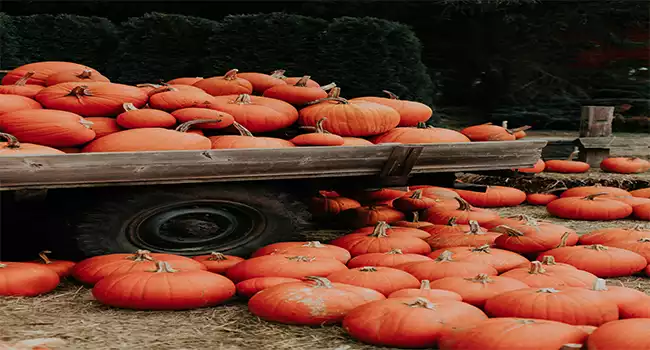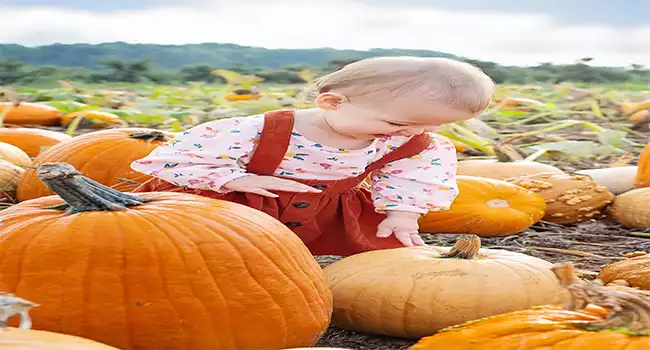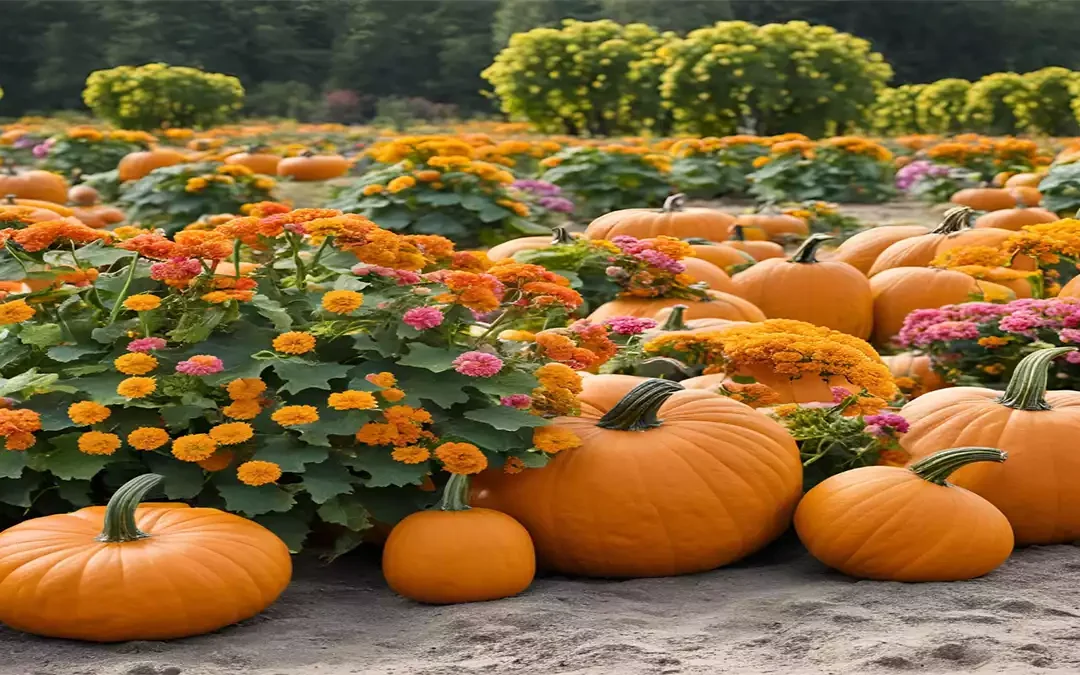Pumpkins are a quintessential symbol of autumn, beloved for their vibrant hues, delicious flavors, and versatility in the kitchen. But growing plump, prize-worthy pumpkins requires more than just sunshine and water. If you dream of those massive orange orbs adorning your porch or a plentiful harvest for your family’s favorite recipes, mastering the art of pumpkin fertilization is key.
Why Your Pumpkins Crave Fertilizer: The Science Behind the Growth
Fertilizing pumpkins isn’t an optional extra; it’s a fundamental step for achieving:
- Vigorous Growth: Proper nutrition fuels the development of strong vines, lush foliage, and a robust overall structure – the foundation for healthy pumpkins. Think of it as giving your pumpkins the building blocks they need to thrive.
- Increased Fruit Production: Adequate feeding translates to not only larger pumpkins but also a more abundant harvest, filling your patch with orange (or white, or green!) treasures. More nutrients mean more energy for your plants to produce those glorious gourds.
- Enhanced Disease Resistance: Healthy, well-nourished pumpkins are better equipped to fend off pests and diseases, ensuring your hard work doesn’t go to waste. Think of fertilizer as a shield, protecting your plants from unwanted threats.
Understanding Pumpkin Nutrition: The NPK Trifecta
Pumpkins are heavy feeders, craving a balanced diet of nitrogen (N), phosphorus (P), and potassium (K), often referred to as NPK. Each of these nutrients plays a crucial role in the pumpkin’s life cycle:
- Nitrogen (N): This nutrient is the engine behind leafy growth and lush foliage, especially crucial during the early stages of pumpkin development. It’s like giving your pumpkins a growth spurt to establish a strong foundation.
- Phosphorus (P): Essential for strong root development and vibrant blooms, phosphorus is the key to abundant fruit production. It’s the magic ingredient that helps your pumpkins produce those beautiful flowers that turn into pumpkins.
- Potassium (K): This multi-faceted nutrient enhances overall plant health, bolsters disease resistance, and improves fruit quality, resulting in pumpkins that are not only bigger but also tastier. Think of it as the vitamin that keeps your pumpkins happy and healthy.
Choosing the Best Fertilizer for Pumpkins: A Garden Variety
There’s no one-size-fits-all pumpkin plant food; your choice depends on several factors:
- Soil Test: Before you start, a soil test is your best friend. It reveals your soil’s nutrient levels and pH, helping you tailor your fertilizer choices for optimal results. You can purchase a soil test kit from a garden center or send a sample to a soil testing lab. For further information, consult your local agricultural extension service (link to relevant resource).
- Pumpkin Variety: Different pumpkin varieties may have slightly varying nutrient needs. Giant pumpkins, for instance, might require a higher phosphorus fertilizer during fruit development, while pie pumpkins might prefer a more balanced blend. Check your seed packet or consult local experts for variety-specific advice.
Types of Pumpkin Fertilizers
- Compost and Manure: These organic amendments enrich the soil and provide a slow-release source of nutrients, creating a healthy environment for your pumpkins. Learn more about the benefits of compost for your garden (link to relevant article).
- Balanced Fertilizers: General-purpose options like 10-10-10 or 5-10-5 offer a good mix of NPK for overall pumpkin health.
- Liquid Fertilizers: For a quick nutrient boost, especially if you notice signs of deficiency, consider fish emulsion or seaweed extract. You can find a variety of liquid fertilizers at your local garden center or online

Expert Tips for Fertilizing Your Pumpkins
Start fertilizing after the first true leaves appear.
1- Early Growth Stage (Seedling to Vine Development)
Use a nitrogen-rich fertilizer like blood meal (12-0-0) or a balanced fertilizer with higher nitrogen (10-10-10) every 2-3 weeks to fuel vine and leaf growth.
Expert Tip: Apply fertilizer around the base of the plant, not directly on the leaves, to avoid burning.
2- Pre-Flowering (Bud Formation)
Transition to a phosphorus-rich fertilizer like bone meal (2-14-0) or a bloom booster (10-30-20) to encourage abundant blooms and fruit set. Supplement with a potassium source like kelp meal (1-0-2) or wood ash.
Expert Tip: Water your plants well after fertilizing to help distribute the nutrients and prevent root burn.
3- Fruit Development
Switch to a potassium-rich fertilizer like sulfate of potash (0-0-50) or a fruit and vegetable fertilizer (5-10-10). Continue applying every 2-4 weeks until harvest.
Expert Tip: Avoid excessive nitrogen at this stage, as it can lead to leafy growth at the expense of fruit production.
Foliar Feeding
Occasionally, consider foliar feeding by spraying a diluted liquid fertilizer like fish emulsion or seaweed extract directly onto the leaves for a quick nutrient boost, especially during hot or stressful weather.
Expert Tip: Apply foliar sprays in the early morning or late evening to minimize evaporation and maximize absorption.
Specialty Pumpkin Fertilizers
Tailored formulas to meet specific needs at different growth stages:
-
-
- Seedling and Vine Growth Formulas (e.g., 10-5-5, 12-6-6): High in nitrogen to boost early growth.
- Bloom Boosters (e.g., 10-30-20, 6-24-12): Rich in phosphorus to encourage flowering.
- Fruiting and Ripening Formulas (e.g., 5-10-15, 3-9-18): High in potassium to support fruit development.
- Giant Pumpkin Fertilizers: Formulated for maximum size with specific nutrients and micronutrients.
- Organic Pumpkin Fertilizers: Offer balanced nutrition from natural ingredients like fish meal, bone meal, kelp meal, and bat guano.
-

Adapting to Your Environment: Weather and Regional Considerations
Pumpkin fertilizer needs can vary depending on your climate and soil conditions.
- Hot, Dry Climates: Pumpkins may require more frequent watering and potentially a lower concentration of fertilizer to avoid stress.
- Cooler, Wetter Regions: You might need to adjust fertilizer timing to accommodate slower growth.
- Soil Type: Sandy soils may require more frequent fertilization due to nutrient leaching, while clay soils might hold nutrients longer.
Common Pumpkin Fertilizer Mistakes to Avoid
- Over-Fertilizing: Excessive fertilizer can lead to lush foliage but poor fruit development. Stick to a balanced schedule and the correct pumpkin fertilizer dosage.
- Using the Wrong Fertilizer: Choose the best fertilizer for pumpkins based on their growth stage, variety, and your soil’s specific needs.
- Ignoring Soil Tests: Soil testing provides valuable insights into your soil’s nutrient content and pH, helping you make informed fertilizer choices.

FAQs About Pumpkin Fertilizer
When should I start fertilizing my pumpkins?
Start fertilizing after the first true leaves appear.
How often should I fertilize?
Generally, every 2-4 weeks is a good guideline. Adjust based on plant needs and fertilizer instructions.
Can I use organic fertilizer on pumpkins?
Absolutely! Compost, manure, blood meal, bone meal, and kelp meal are excellent organic choices for pumpkin food.
What do the three numbers on a fertilizer package represent?
The three numbers (e.g., 10-10-10) represent the NPK ratio, indicating the percentage of nitrogen, phosphorus, and potassium in the fertilizer.
How do I know if my pumpkin plants need fertilizer?
Look for signs like slow growth, yellowing leaves, or poor fruit development. A soil test can help pinpoint deficiencies.
Can I fertilize pumpkins too much?
Over-fertilizing can harm your plants. Follow recommended application rates and avoid excessive nitrogen, especially during fruit development.
Why is fertilizer important for growing pumpkins?
Pumpkins are heavy feeders, needing plenty of nutrients to fuel their vigorous plant growth and support the development of large, healthy fruits. Best fertilizers provide essential nutrients like nitrogen, phosphorus, and potassium, promoting healthy pumpkin vines, lush pumpkin leaves, and abundant pumpkin growth.
When is the best time for fertilizer application?
Start fertilizing when your pumpkin seeds sprout, usually 2-3 weeks after planting pumpkins. Continue fertilizing every 3-4 weeks throughout the pumpkin growing season, tapering off as the fruits mature to avoid excess vegetative growth.
What are the best fertilizers for pumpkins?
Pumpkins thrive on balanced fertilizers with a higher nitrogen content early in the season to promote leafy growth, transitioning to a higher phosphorus and potassium formula for fruit development. Both synthetic fertilizers and organic fertilizers like compost and manure can be used successfully.
How do I apply fertilizer to my pumpkins?
For granular fertilizer, sprinkle it around the base of the pumpkin plants, keeping it a few inches away from the stems. Water well afterwards to help the fertilizer dissolve and reach the roots. Liquid fertilizers can be diluted and applied directly to the soil or as a foliar spray on the pumpkin leaves.
How do I protect my pumpkins from pests and diseases?
Maintaining healthy pumpkin plants through proper fertilizer application and watering is the first line of defense. Additionally, using organic mulch can help suppress weeds, retain soil moisture, and deter pests like vine borers.
Can I grow pumpkins in containers?
Yes, you can successfully grow pumpkins in containers as long as you choose a large enough pot (at least 15-20 gallons) with good drainage. Use a well-draining potting mix enriched with compost or other organic fertilizers, and ensure consistent watering and fertilizer application to keep the pumpkin plants healthy. You may need to provide a trellis or other support for the pumpkin vines to climb.
What is the ideal soil temperature for pumpkin seeds to germinate?
Pumpkin seeds germinate best in warm soil temperatures between 70°F and 85°F (21°C-29°C). Planting in a warm location or using peat pots to start seeds indoors can help ensure successful germination.
Pumpkin Fertilizer Conclusion:
By following these expert tips and providing your pumpkins with the nourishment they need, you’ll be well on your way to a bountiful harvest of healthy, flavorful pumpkins. Remember, proper fertilization is the key to unlocking the full potential of your pumpkin patch!
As a pumpkin grower, mastering the art of fertilization is key to unlocking the full potential of your pumpkin plants. By understanding the specific needs of pumpkins at each growth stage, you can tailor your fertilizer application to optimize plant pumpkin health, encourage vigorous pumpkin growth, and ultimately harvest a bumper crop of beautiful pumpkins.
Remember to start your pumpkin seeds in warm peat pots with nutrient-rich soil, providing ample nitrogen fertilizer to fuel early growth. As your plants mature, transition to a balanced fertilizer or one with higher phosphorus and potassium to support flowering and fruit development. Whether you choose dry fertilizer or liquid formulas, consistent application and careful monitoring will help you achieve the best results.
By following these pumpkin growing tips and choosing the right fertilizer for each stage of growth, you’ll be well on your way to becoming a successful pumpkin grower with a bountiful harvest to show for your efforts. So go ahead and grow pumpkin with confidence, knowing you have the knowledge and tools to nourish your plants and enjoy the fruits of your labor.
Let us know in the comments below what fertilizer techniques you’ve found most successful for your pumpkins!

